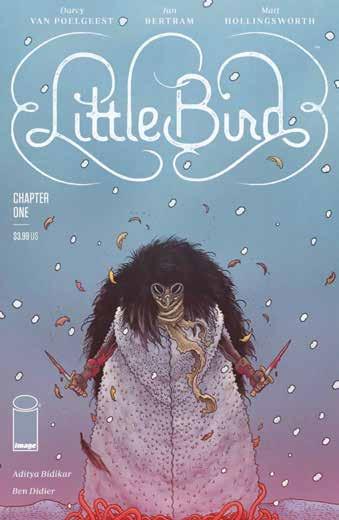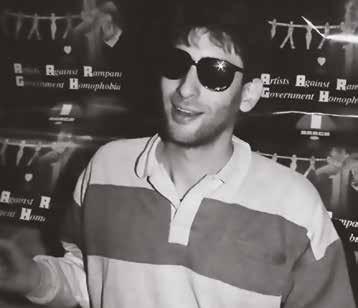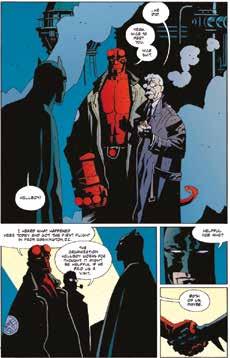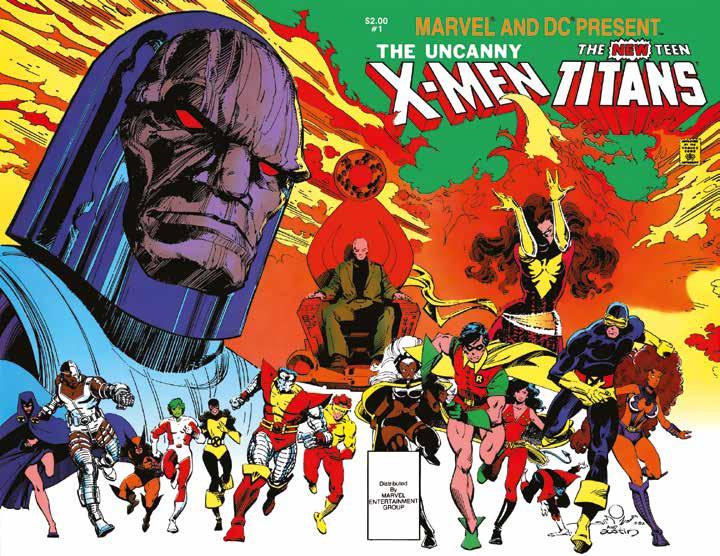
14 minute read
State Of The Industry
With the coronavirus affecting everything earlier this year including the comics industry, Tripwire spoke to a number of people at the top of a cross-section of comic publishers including Image, Aftershock and Boom to find out how they have adapted in a year that has seen so many huge changes including no comic conventions taking place and the comic shops temporarily shutting down. Then we took a look at how comic retailers have been coping in the US and UK with the changes that the virus has brought to their businesses…
TRIPWIRE: How did Image react once the coronavirus hit and the comic shops temporarily shut, with Diamond forced to close down distribution of new comics? ERIC STEPHENSON: It was a shock. It certainly wasn’t something we’d anticipated or prepared for, and I think everybody was caught off guard by how quickly and dramatically things changed. To some degree, I think we’re all still reeling a little bit. TW: How has Image adapted to a postcoronavirus comic market? ES: Considering COVID-19 is still very much a part of our lives here at the end of the summer, I think it’s going to be a while before we’re in the “postcoronavirus” phase of things. The comics market has proven surprisingly resilient, is that retailers and readers are able to clearly see who has their back. And I get that just sounds like a standard dig at our competitors, but the truth of the matter is that comics retail is not an easy business. There are publishers who have made that business more difficult by their actions, and when things are more difficult for the stores, it’s more difficult for all of us. Sure, publishers compete with each other in this marketplace, but we also exist alongside each other in the same space. Taking a wrecking ball to any part of that space without consideration for how it affects everyone from readers to retailers to business partners and even to competitors is irresponsible. though, and I’m happy to say we’ve Everyone has had to pick up the adapted quite well to working within slack, and for our part, we’ve been the limits of current restrictions. Not working hard to make sure that shipping for two months wasn’t ideal, stores understand we have their best but what we’ve seen is that readers are interests at the forefront of our minds. still hungry for content. We’ve gone Like most stores, the nature of how back to press on a lot of our books, we operate means we’re a small and we’re seeing sales climb on many business, too – and that extends to series. Right now, September is shaping the creators we work with. We get up to be one of our best months of the that we’re part of a larger ecosystem year, and I put that down to the quality and that stores can’t get by without of the talent we’re working with, and our help and vice versa. the dedication of the Image staff, all of whom have more than risen to the TW: With comic cons currently challenge of working remotely. suspended, how long do you think TW: What has changed in the comic market in the wake of the virus? ES: Well, sadly, the biggest change it’ll be before they start up again? ES: I’d be surprised if there are cons before a vaccine is approved. The smart move would be to sit things is that some publishers have become out until 2022 I would think, but more craven, but the bright side of that who knows how that will play out.
Advertisement


TW: With cons playing such a major part in comic publishers’ business models, just how do you adapt to a world that temporarily doesn’t have comic cons in it? ES: It’s funny – I haven’t heard anyone complain about the temporary absence of comic book conventions from their lives. Most people seem happy to have had a year off from it. Does it hurt business? They’re marketing endeavours, more than bonafide sales events, and while it’s good exposure to be there, it’s also usually a big chunk of the budget that we’re able to re-distribute elsewhere right now.

TW: Is there anything positive that will come out of the impact of the virus in the medium and long term for Image and the comic market? ES: In the short term, I think we’ve had a chance to kind of catch our breath and re-evaluate some aspects of our business in a way we probably wouldn’t have done otherwise. As you know, we all work in a very hectic business. As an industry, we’re


responsible for hundreds of comics a month, and it just never stops. It’s a high stress job that doesn’t always leave room for a lot of reflection inbetween the constant deadlines. So as unfortunate as this whole situation has been, having the ability to slow down and take a step back to reassess things has been very valuable, and I would hope that goes for others as well and not just Image. Overall, I think some of the changes we’re going through, some of the upheaval we’ve endured and continue to deal with, will result in new opportunities for all of us. I often say that one of the things I’ve always found most appealing about Image is that we look almost completely different from one year to the next, because we’re constantly working with different creators and those creators are constantly doing different things. That’s how you get Eisner-winning work like Chuck Brown, Sanford Greene and David Walker’s Bitter Root, or Ian Bertram and Darcy Van Poelgeest’s Little Bird. That’s what our industry should like, too – all-new, alldifferent, all the time. There are certain points in our history this business has looked kind of like a bug trapped in amber, but right now, I think the opportunities in front of us point to a period of tremendous change that will benefit all of us.
TW: What is the one thing that Image has learnt that is invaluable to reacting to a major worldwide business disruption like the coronavirus? ES: As sappy as this might sound, I think the most vital lesson we’ve learned from all this is to “keep calm and carry on.” www.imagecomics.com
Dream Career


Neil Gaiman has had a career that started with comics but has encompassed novels, radio, television and films. Olly MacNamee takes a look at the writer’s impressive body of work…
JRR Tolkien, C S Lewis, J K Rowling and Neil Gaiman. All authors who have left their indelible mark on the celebrated British world of fantasy, myth and legend and in doing so created many magical worlds in their wake. Worlds that have given countless readers so much escapist pleasure over the years. And, in the case of both
Rowling and Gaiman, continue to do so.
Neil Gaiman is a modern master storyteller who has spent a career – thus far – working his magic in the genre of fantasy, not to mention his efforts in the world of capes and cowls and other Neil Gaiman signing at London’s Forbidden Planet in genres too. He even got to write 1988. photo©1988 Forbidden Planet.

an episode of Doctor Who.
Unlike Tolkien, his is a contemporary fantasy setting, albeit informed by the myths and archetypes of antiquity. And, like Tolkien, Gaiman has created a shared universe with his work on The Sandman for Vertigo that will no doubt endure. It’s clear from DC Comics’ launch of a Sandman Universe line the other year that his legacy is manifest and for the ages. His interests in folklore, stories of yesteryear and all things Joseph Campbell shine through as he weaves his signature themes on the real and the imagined into his work. His masterful ability to blend the supernatural with the naturalistic is beguiling and mystifying.
It’s this title – The Sandman - that Gaiman, arguably, is still best known for among us comic book aficionados, and one that brought him superstar status across pop culture. It was a book that wasn’t quite like anything DC Comics was publishing at the time, and a great way to launch a new more mature imprint at a time when DC Comics were looking to create a brand for their heavyweight writers like Alan Moore, whose Swamp Thing had kickstarted the move towards It. Karen Berger, who had read Gaiman’s interpretation of Black Orchid and his repositioning of the character as an ecowarrior, immediately offered Gaiman a chance to write and oversee his own series. Lest we forget, at this time there hadn’t been that much radical reworking of older characters, as there is today, and his take on Black Orchid was inspirational. Dave McKean’s artwork cemented this as a title not to ignore.
Berger initially wanted him to refit and re-imagine the Sandman character created by Jack Kirby in his short time at



franchises in the late 20th century.
And, while Gaiman is best known for his work for American publishers, his stories have more than a touch of the English fairy tale tradition about them. His worlds are filled with ancient woodlands, vistas of rural landscapes (check out Stardust for a great example of this) and Arthur Rackham-esque goblins, pixies and brownies. Having worked on Miracleman after his mentor Alan Moore, Gaiman was a known entity. His run on that much- missed title is still highly rated among older comic book readers, with Marvel having neglected the property, having previously promised us a completion of his ‘Silver Age’ storyline. It remains to be seen whether Gaiman will ever finish his work on the title.
Sandman allowed Gaiman to explore many of his interests while also remaining grounded in the more familiar world of superheroes. But these masked vigilantes rarely intruded on the Sandman universes. Although the Sandman Gaiman has left as a legacy to DC very much had one foot in the DCU when he was revealed to be the son of old-school 80s heroes Silver Scarab and Fury, themselves children of Silver Age characters Hawkman and Wonder Woman respectively. And, with Scott Snyder and Greg Capullo’s Dark Nights: Metal series the Sandman is once again well and truly rooted in the DCU, while the Sandman Universe of books - a Vertigo-light DC Comics imprint -


Speed Kings

Tripwire’s senior editor Andrew Colman casts his eye over the various incarnations in the history of DC’s Scarlet Speedster in the year that The Flash celebrates his 80th anniversary…

CrossingUniverses
Tripwire’s contributing writer Scott Braden takes a look at the history of that phenomena, the intercompany crossover…
There is no “I” in team. That is saved for intercompany crossovers.
In comicdom, an intercompany crossover (a.k.a. crosscompany or company crossover) is a comic book or series of comics where characters that at the time of publication are the property of one company meet those owned by another company (for example, DC Comics’ Superman meeting Marvel’s Spider-Man). These usually occur in “one-shot” issues or limited series.
Some crossovers are part of canon. But most are outside of the continuity of a character’s regular title or series of stories. They can be a joke, a gag, a dream sequence, or even a “what if” scenario (such as DC’s Elseworlds).
Although Avengers/JLA is in canon – which is the exception – most Marvel/ DC crossovers are not. They include those where the characters live in alternate universes, as well as those where they share the same earth. Some fans have posited a separate “Crossover Earth” for these adventures. In the earliest licensed crossovers, the companies seemed to prefer shared world adventures. This was the approach for early intercompany crossovers, including 1976’s Superman vs. the Amazing Spider-Man and 1981’s Superman and Spider-Man. A number of other DC/Marvel adventures take place on a “Crossover Earth,” but later intercompany crossovers tend to present the DC and Marvel Universes as alternate realities, bridged when common foes make this desirable, as the interest in overall continuity has become a major part of even crossover comic books.
Characters are often licensed or sold from one company to another, as with DC acquiring such characters of Fawcett Comics, Quality Comics, Charlton Comics, and WildStorm Productions as the original Captain Marvel, Plastic Man, Captain Atom, and Midnighter, respectively. In this way, heroes originally published by different companies can become part of the same fictional universe, and interactions between such characters are no longer considered intercompany crossovers.
According to Wikipedia: “Although a meeting between a licensed character and a wholly owned character (e.g., between Red Sonja and Spider-Man, or Evil Dead’s Ash Williams and the Marvel Zombies) is technically an intercompany crossover, comics companies rarely bill them as such. Likewise, this is the case when some characters in an ongoing series are owned or to some extent controlled by their creators, as with Doctor Who antagonists the Daleks, who are not owned by the UK television


network the BBC, even though the character of the Doctor is.”
One tremendously successful intercompany crossover that comes to mind is 1982’s X-Men/Teen Titans one-shot by longtime X-scribe Chris Claremont and superstar artist Walter Simonson. Published by Marvel Comics, the special found the two titanic teams against DC Comics’ Darkseid and the House of Ideas’ Dark Phoenix with the fate of the universe at stake. Then, there is the exceptional Batman/Starman/ Hellboy with script by the enormously talented James Robinson and illustrated by comic book master Mike Mignola. With talent like that, ‘nuff said!
Speaking of Hellboy, another example to consider is Dark Horse Comics. It may be true in the stark reality that the publisher’s “Comics’ Greatest World” titles or “Dark Horse Heroes” line, whatever you the reader prefer to call it, arguably failed to garner a larger readership on its own – but that doesn’t change the fact that the line’s crossovers with other properties proved to find substantial sales success and fan appeal.
The Ghost/Hellboy Special twoparter has proven to be one of the more successful “Comics’ Greatest World” crossovers over time, having been collected in a prestige formatstyle trade paperback that continues to generate great collector interest in



the comic book aftermarket. A reason for this may be that the tale – which had Hellboy travel to Arcadia to see if Ghost was, in truth, a honest-to-God gun-toting apparition and femme fatale – wasn’t
State Of The Industry







